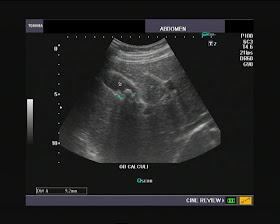This was a normal 32 week old fetus. One of the best ways to visualize the fetus is a cross sectional anatomy. But since one plane alone is not sufficient, we tried to take sections along various oblique planes.
The first ultrasound video is that of the right dome of
fetal diaphragm:
The fetal diaphragm is seen as a hypoechoic curved line between the liver and the right lung. Observe the movements of the diaphragm with fetal respiratory attempts.
(abbreviations: LG= fetal right lung; H= fetal heart; LIV= fetal liver)
Here is a still ultrasound image of the right dome of diaphragm.
Fetal Liver and Gall bladder:
Perhaps the easiest and most prominent structure in the fetal abdomen is the liver. This is seen as a large echogenic structure occupying the right hypochondrium of the fetus with a number of vessels passing through it. The fetal gall bladder is seen within this structure (the liver) as an anechoic pear shaped, elongated structure. The gall bladder is best appreciated in color Doppler imaging.
Note in the above color Doppler ultrasound video, that the gall bladder shows no flow unlike the umbilical vein and other nearby vessels.
This still ultrasound picture shows the gall bladder through the fetal liver:
And this color Doppler image helps differentiate the gall bladder from the vessels nearby:
The fetal stomach:
Visualization of the fetal stomach is important to rule out esophageal atresia, pyloric stenosis and duodenal atresia. The fetal stomach is seen as an anechoic bubble in the left upper quadrant of the fetal abdomen.
This ultrasound video clip shows the normal fetal stomach (arrow) to the left of the spine in the left hypochondrium. Care must be taken to determine if the stomach is indeed on the left side of the abdomen and thus rule out situs anomalies (situs inversus etc).
Ultrasound image showing the normal fetal stomach- the dark "bubble" - to the left of the liver:
Fetal Kidneys:
The fetal kidneys must be visualized and measured. Aplasia, hypoplasia or absence of one or both kidneys must be ruled out. Also, the sonographer/ radiologist must look for renal masses, cysts and hydronephrosis. Pelviureteric junction obstruction and posterior urethral valve in the fetus are common findings and important causes of fetal hydronpehrosis. The above video clip shows the normal left fetal kidney, next to the spine.
Still image of the normal left kidney in fetus:
The right fetal kidney is seen in this ultrasound video clip.
Still ultrasound image of normal right kidney: (long axis view)-
See this 2nd video clip of the normal right kidney. Note the hypoechoic triangles within the kidneys- these are normal renal pyramids (part of the renal medulla). Observe how the fetal kidneys move with fetal respiratory movements.
Both kidneys must be visualized in both long and transverse axes: this transverse section ultrasound image shows both fetal kidneys-
Fetal adrenal (suprarenal) glands:
The fetal adrenals (suprarenal glands) must be carefully visualized to rule out abnormalities including masses (neuroblastoma) and cysts. The suprarenal glands are seen as triangular caps above the upper pole of each kidney. They have an echogenic central part with a hypoechoic layer outside. The above video clip shows a transverse section through the right suprarenal gland.
A still image of the fetal right adrenal gland is seen below (this is an oblique section through the gland):
One more ultrasound image of the right suprarenal gland is shown here- ( the image below is a coronal section of the right kidney and the right suprarenal gland)
This is a longitudinal section through the right kidney and right adrenal gland.
Umbilical vein (intra fetal part):
The umbilical vein is seen coursing through the liver (color Doppler ultrasound video clip-at right). This vein carries oxygenated blood from the placenta to the fetus.
The fetal abdominal aorta and the iliac arteries:
The normal abdominal aorta is seen in this coronal section ultrasound image, dividing near the pelvis into the common iliac arteries (arrows).















































